
This completed free dissertation example on “Diffusion of Product Innovation through Identifying Communities of Practice Networks in UAE Healthcare Organizations” includes all chapters (1 through 5), including all sections within each chapter, such as an introduction, statement of problem, purpose of study, importance of study, rationale of study, review of literature, methodology, study approach, data-gathering, data analysis/findings, summary/conclusion/recommendations and resources. By using this example it should help you understand the correct format of a dissertation as well as give you ideas on how to complete your own.
Chapter 1: Introduction
Statement of the Problem
Purpose of Study
Importance of Study
Rationale of Study
Overview of Study
Chapter 2:
Chapter 3:
Methodology
Description of the Study Approach
Data-gathering Method and Database of Study
Chapter 4:
Chapter 5:
Conclusion, Recommendations, and Reflections
Other:
[Insert]
Innovations in technology and healthcare have revolutionized the manner in which clinicians collaborate within social networks of various types, including so-called communities of practice. Communities of practice have been shown to provide their members with a group of peers whom they can contact quickly and easily through technology, pose issues or specific problems, and obtain suggestions, in a relatively short time-frame. Therefore, Communities of Practice can help organizations transform from the traditional multidivisional or M-form organization into more competitive learning, or L-form, organization. This dissertation sought to discover if communities of practice networks exist in UAE healthcare industry, to define those areas of the communities of practice that are adjusted to the greatest levels of knowledge-based velocity and therefore diffusion of innovation based on trust. The diffusion maturity models for new processes and new products also have to be taken into account, and corresponding frameworks also created for them as well.
Diffusion of Product Innovation through Identifying Communities of Practice Networks in UAE Healthcare Organizations
“None of us is as smart as all of us.” — David R. Bender, 2000, p. 5
Chapter One: Introduction
Today, healthcare organizations are typically characterized by complexity, an enormous investment in infrastructure and a multidisciplinary cadre of clinicians. These clinicians may or may not be receptive to innovations in technology and product development depending in some measure on how their colleagues view these innovations. When efficient networks exist among healthcare practitioners, the data-sharing practices that are needed to communicate this type of information are improved and innovations may be more readily adopted on a widespread basis. According to Rogers (2003, 5), diffusion is the process in which an innovation is communicated through certain channels over time among the members of a social system. Communities of Practice are an example of such social systems. For the diffusion of innovation to be effective in any Community of Practice (CoP) network, the synchronization of the factors of communication channels, rate of adoption, and characteristics of the social system both from a social structure and communication structure need to be taken into account. To the extent these factors are in alignment with each other is the extent to which there is an effective diffusion of innovation (DoI), optimization of resource allocation, and the stability to create an ethical framework. When a CoP has attained this level of efficiency across these three dimensions, the tendency of its structure to create a learning ecosystem also begins to emerge (Chang, Harrington Jr., 937). Learning ecosystems help to minimize resistance to change by concentrating on assimilating knowledge through reciprocal sharing of insights, the creation of process-based taxonomies, and the development of governance frameworks for the continual improvement and growth of them (Grossmeier, 346).
The main purpose of the dissertation was to develop timely and informed answers to the following guiding research question and sub-questions concerning the diffusion of innovation and its application in the healthcare system in UAE:
RQ: Do social networks and communities of practice (CoP) exist in UAE healthcare system and can leaders be identified?
Sub-question 1: How can the CoP data be used to improve the diffusion of new innovation between healthcare professionals?
Sub-question 2: How can pharmaceutical companies activate CoP networks to improve their resource allocation?
Sub-question 3: How can pharmaceutical companies harness the benefits of CoP within their ethical framework?
Improvements in competitiveness and productivity of nations today depend on the introduction and diffusion of innovation among firms (Vázquez-Barquero, 2002). The diffusion of innovation throughout healthcare organizations often begins in the knowledge management, support services and decision support systems areas due to these processes having a direct impact on quality of care (Wong, Legnini, Whitmore, Taylor, 2000, 249). Moreover, researchers, theorists, and practitioners from many fields are interested in and affected by the diffusion of innovations within and across organizations, including organization development, education, management, health care and public health, information technology, and sociology. Many of these fields have a shared interest in organizational improvement, yet there is evidence that innovations often are not diffused within and across organizations to achieve improvement (Lundblad, 2003, 50). A few examples illustrate the issue, and provide a background for why diffusion of innovation is an important topic from both theoretical and practice perspectives. In healthcare settings, new clinical and process advancements are continuously developed in research and practice settings, yet these innovations often take years, if not decades, to spread into wide use (Lundblad, 2003). Process innovations are often low or no cost changes that a health care delivery organization can make, such as reminder systems, pathways, and clinical guidelines, yet they still do not find their way into practice (Lundblad, 2003).
The propensity of a CoP to serve as the catalyst for creating greater levels of knowledge transfer and corresponding trust is also a key determinant in the productivity of healthcare communities throughout communities and regions (Fuentelsaz, Gómez, Palomas, 1172). From a more pragmatic perspective, in order for the UAE healthcare community to nurture and grow CoPs, there must be a concentration on knowledge sharing, the evaluating of new medical products (Carter, 20) to more efficiently and completely treat patients, and a recognition of the fact that continual improvement will require continual measurement as well (Inamdar, Kaplan, Reynolds, 179). From the qualitative aspects of the steps required to create a CoP and continually grow it through the use of knowledge sharing and the creation and maintenance of a knowledge management system, there must be strong leadership for this type of socially-based community to stay in existence and grow over time.
Any CoP must also be outward centered, looking at the unmet needs of those professionals in the UAE healthcare community who seek to continually improve and learn. Any CoP, to stay relevant, must have this outward-facing set of priorities and concerns not only about recently introduced medical technologies (Carter, 20) and their implications on broader technology acceptance and adoption (Bernstein, McCreless, Côté, 17) but more importantly on their diffusion through the UAE medical community (Huesch, 1270). There must be an aspect of environmental scanning for best practices or approaches making the greatest increases in efficiency to critical healthcare processes too if the CoP is going to grow in its value to those who are members. In this regard, Lee and Valderrama (2003) note that, “CoPs are created to connect individuals with a common interest, so they can exchange knowledge objects, best practices, and lessons learned” (p. 29). In sum, in order for any CoP to be effective, there must be constant attention to learning and to allowing for the gradual diffusion of innovation based on the level of acceptance to change within the CoP itself. Inherent in this gradual diffusion of innovation also is the concept of a maturity model. Therefore, for any CoP to be effective in continually meeting the needs of its members, a maturity model of diffusion must also be created and fine-tuned over time so that the CoP will stay relevant, continually accumulating and sharing knowledge with its members.
Etienne Wegner provides a useful definition of communities of practice as being groups of people who share a concern or a passion for something they do and want to learn how to do it better by regular interactions with each other. Communities of practice can provide the framework in which group members can interact effectively with peers through rapid technology-enabled communications to discuss timely issues of mutual concern in a collaborative effort to solve problems and obtain recommendations (Hemmasi & Csanda, 2009, p. 262). Consequently, mature communities of practice are capable of assisting organizations make the transition from a traditional multidivisional or M-form organization into more competitive learning, or L-form, organization (James, 2002). According to Wegner (1991) and Hemmasi and Csanda (2009), the primary characteristics that serve to identify a group as a community of practice include the following: (a) a recognized domain of interest that the group members share an interest in and commit to, (b) relationships between group members that allow them to engage in joint activities, share information and help each other, and (c) the development of a shared practice that consists of experiences, stories, tools, shared resources, and so forth. Likewise, Wesley and Buysse (2001) emphasize that, “Compared to other collaborative research-practice approaches that appear in the literature such as action research or professional development schools, communities of practice may offer the most promise for altering the linear relationships through which information is handed down from those who discover the professional knowledge to those who provide and receive services” (p. 114).
The ability of practitioners to develop shared knowledge in these environments, though, is not an automatic process but rather requires that community members actively engage in information-sharing process that help to consolidate and use the information that is available in ways that help to define sets of best practices; however, since the goal of such communities of practice enterprises is not static or restricted to a single area of investigation, the development and maintenance of communities of practice tend to forge enduring relationships among their membership that can result in viable networks that are characterized by solid relationships and trust (Buysse, Sparkman, Wesley, 263).
Moreover, CoPs develop their practice through improving the diffusion of innovation within their active networks; the benefits of such interactions are countless especially in the field of healthcare. One can assume that specialty doctors’ communities would present the perfect example for CoPs because they share the same practice, interest and professionalism. It would be interesting to study if those CoP networks exist in United Arab Emirates, whether they are active or not and whether leaders can be identified. Collecting such data will enable this project to measure if the rate of diffusion of new innovation can be improved and hence be used by pharmaceutical companies in UAE to improve their resource allocation; all within healthcares’ ethical framework.
This dissertation used a five-chapter format to achieve the above-stated research purpose. To this end, chapter one introduced the topic under consideration, a statement of the problem, the purpose and importance of the study, as well as its scope and rationale. Chapter two below provides a review of the relevant peer-reviewed and scholarly literature concerning the current healthcare context of the UAE, an overview of communities of practice in general and how these communities tend to mature over time. Chapter three is used to describe more fully the dissertation’s methodology, including a description of the study approach, the data-gathering method and the database of study consulted. Chapter four of the dissertation consists of an analysis of the data developed during the research process and chapter five presents relevant conclusions, recommendations and personal reflections.
Context of Setting
The UAE currently has 40 public hospitals, a number that represents a major increase from just seven which was the case in 1970 (UAE country profile, 7). Moreover, the UAE Ministry of Health has launched a multimillion-dollar program in order to enlarge the country’s existing health facilities and hospitals, medical centers to serve all of the seven emirates (UAE country profile, 7). An ultra-modern general hospital has been constructed in Abu Dhabi with a projected bed capacity of 143, including a trauma unit, and will serve as the framework for the development of a home health care program in the UAE. In addition, in an effort to attract affluent UAE nationals and expatriates who traditionally have traveled abroad for their health care services, Dubai is also developing Dubai Healthcare City; this facility will offer state-of-the art evidence-based private healthcare services to UAE healthcare consumers as well as serving as an advanced academic medical training center, with the completion of these facilities scheduled for later this year (UAE country profile, 7).
There is also a growing need for heart specialists in the UAE with the current principal cause of death being cardiovascular disease, accounting for fully 28 percent of all deaths in the country (UAE country profile, 7). The primary causes of these casualties include accidents and injuries, malignancies, and congenital anomalies (UAE country profile, 7). In addition, the UAE launched a national initiative designed to prevent transmission of acquired immune deficiency syndrome (AIDS) and to control its entry into the country in 1985, an initiative that has been effective. For instance, according to World Health Organization estimates, in 2002?3, there were less than 1,000 people in the UAE who had been infected with the human immunodeficiency/ AIDS virus (UAE country profile, 7). There is also a growing need for heart specialists in the UAE with the current principal cause of death being cardiovascular disease, accounting for fully 28 percent of all deaths in the country (UAE country profile, 7). The primary causes of these casualties include accidents and injuries, malignancies, and congenital anomalies (UAE country profile, 7). In addition, the UAE launched a national initiative designed to prevent transmission of acquired immune deficiency syndrome (AIDS) and to control its entry into the country in 1985, an initiative that has been effective. For instance, according to World Health Organization estimates, in 2002?3, there were less than 1,000 people in the UAE who had been infected with the human immunodeficiency/ AIDS virus (UAE country profile, 7).
A brief overview of healthcare metrics for the UAE is provided in Table 1 below.
Table 1
Healthcare overview of UAE
| Healthcare Category | Statistics | World Rank |
| Birth rate, crude > per 1,000 people | 15.59 per 1,000 people | [121st of 195] |
| Children Underweight Rate | 3% | [61st of 95] |
| Contraception | 28% | [63rd of 89] |
| Dependency ratio per 100 | 36 | [167th of 166] |
| Drug access | 95% | [50th of 163] |
| HIV AIDS > Adult prevalence rate | 0.18% | [104th of 136] |
| Hospital beds > per 1,000 people | 2.2 per 1,000 people | [43rd of 149] |
| Life expectancy at birth > Female | 78.56 years | [74th of 226] |
| Life expectancy at birth > Male | 73.35 years | [69th of 226] |
| Life expectancy at birth > Total population | 75.89 years | [71st of 225] |
| Life expectancy at birth, total > years | 79.18 years | [23rd of 194] |
| Maternal mortality | 3 per 100,000 | [135th of 136] |
| Physicians > per 1,000 people | 2.02 per 1,000 people | [50th of 148] |
| Plastic surgery procedures | 783 | [32nd of 34] |
| Probability of not reaching 40 | 5.4% | [97th of 111] |
| Probability of reaching 65 > Male | 75.8% | [35th of 159] |
| Smoking prevalence, males > % of adults | 17.3 % | [36th of 42] |
| Spending > Per person | 1,428 | [21st of 133] |
| Total expenditure on health as % of GDP | 3.1% | [176th of 185] |
| Water availability | 58 cubic meters | [168th of 169] |
Source: NationMaster, 2010 at http://www.nationmaster.com/country/tc-united-arab-emirates/hea-health
The UAE is also considered to have the best telecommunications network in the entire Arab World with the highest voice connection and broadband Internet connectivity capacity per capita; in addition, the UAE also has the lowest mobile-phone rates in the Arab world (US$0.06 per minute) (UAE country profile, 19). According to U.S. government analysts, in 2005 the UAE had more than 4.5 million mobile cellular telephone subscribers, as compared with 1.2 million landlines in use (representing a penetration rate of 101 and 28 lines per 100 residents, respectively). The technology that is used for domestic lines includes microwave radio relay and fiber optic and coaxial cable (UAE country profile, 19). Furthermore, as of 2009, the UAE had almost 400,000 Internet hosts and almost three million Internet users (UAE, 2010), clearly indicating the country’s ability to facilitate the communication requirements for traditional as well as virtual communities of practice, and these issues are discussed further below.The UAE is also considered to have the best telecommunications network in the entire Arab World with the highest voice connection and broadband Internet connectivity capacity per capita; in addition, the UAE also has the lowest mobile-phone rates in the Arab world (US$0.06 per minute) (UAE country profile, 19). According to U.S. government analysts, in 2005 the UAE had more than 4.5 million mobile cellular telephone subscribers, as compared with 1.2 million landlines in use (representing a penetration rate of 101 and 28 lines per 100 residents, respectively). The technology that is used for domestic lines includes microwave radio relay and fiber optic and coaxial cable (UAE country profile, 19). Furthermore, as of 2009, the UAE had almost 400,000 Internet hosts and almost three million Internet users (UAE, 2010), clearly indicating the country’s ability to facilitate the communication requirements for traditional as well as virtual communities of practice, and these issues are discussed further below.
Communities of Practice
One of the most developed and widely practiced models across many types of organizations today is the community of practice (Brown & Duguid, 2000). This is particularly true in such process-intensive operations as healthcare (Hemmasi & Csanda, 2009). According to Bounfour (2003), “The installation of ‘communities of practice’ has as its ultimate goal the organisation of a dynamic dialogue between the tacit knowledge of individuals and the formalised knowledge of the firm” (p. 164). The research to date suggests that communities of practice appear to be an evolution, continuation and amplification of the team concept (Wenger et al., 2002).
Although conventional teams have been highly successful over the years, communities of practice appear to be particularly well suited to provide additional benefits by being more responsive in dealing with the opportunities and challenges of today’s rapidly changing environment, growing global competition, and the ever advancing information technology. Moreover, communities of practice can provide organizations with the framework they need to ensure that the tacit or implicit knowledge that is present in an organization is not lost by forging connections between individuals who share comparable interests in ways that help diffuse the information to all community members (Hemmasi & Csanda, 2009). Furthermore, as Droege and Hoobler (2003) point out, CoPs are structures that can effectively prevent loss of tacit knowledge associated with employee turnover by providing the connections necessary for transfer and retention of knowledge.
One of the original groups that has been consistently cited as being among the pioneers in the formation of communities of practices concerned machine repairman for Xerox (Brown & Duguid, 2000). The results of a study of these community members showed that working in knowledge-sharing groups can help to transform companies into learning organizations. In this regard, a more recent study by Anand, Gardner and Morris (2007) of consulting firms documented the efficacy of communities of practice as being effective knowledge-based frameworks that were able to help fuel innovation. Likewise, a review of communities of practice adoption by the government of the Netherlands conducted by Kranendonk and Kersten (2007) concluded that these groups represent viable ways to help draw on the “wisdom of the crowd” to identify solutions to problems that could not be solved by single individuals. In this regard, McDermott (1999) suggests that there are three basic considerations an organization should take when designing a CoP; in this regard, organizations should determine:
1. The kinds of knowledge that will be shared in the group–i.e., explicit or tactic knowledge;
2. The group’s sense of identity; and,
3. The extent to which the knowledge shared is integrated into actual work (26).
There have been some conflicting reviews concerning how communities of practice are created and sustained, with some authorities (Wenger, McDermott & Snyder, 2002) suggesting that the majority of such groups are created voluntarily and informally and that this is a prerequisite for success; by contrast, other authorities (Perry & Zender, 2004) have found that it is possible for professional communities of practice to be formed in purposeful ways that contribute to their sustainability (Hammasi & Csanda, 2009).
Lave and Wenger (1991) are credited with introducing the term, “communities of practice,” in an attempt to better define the need for forging more cohesive communities and to help legitimize the practices of individuals. By and large, communities of practice concern a group of people who hold in common certain defined beliefs, practices, and understandings that extend over time in an effort to achieve a common goal (Wenger, 1998). Based on his review of recent trends, Roth (1998) believed that these emerging communities “are identified by the common tasks members engage in and the associated practices and resources, unquestioned background assumptions, common sense, and mundane reason they share” (p. 10). These foregoing references to communities of practice, though, do not provide a useful working definition for the term. In this regard, Lave and Wenger defined a community of practice thusly: “[Community does not] imply necessarily co-presence, a well-defined identifiable group, or socially visible boundaries. It does imply participation in an activity system about which participants share understandings concerning what they are doing and what that means in their lives and for their communities” (p. 98).
Definitions of communities, their characteristics and an individual’s participation in a community are all relevant to the manner in which innovation is diffused throughout the network of members and how important they consider their membership and the information they receive as a result of their participation. In this regard, based on the studies to date in fields such as anthropology, education, and sociology, Table 2 below sets forth the different types of communities and their corresponding features that are consistently present and which represent some of the fundamental features of communities that appear to be particularly relevant to communities of practice that have found the best way of forging the type of network that best satisfies their collective personal and professional needs.
Table 2
Characteristics of a community
| Community Type | Description |
| Common Cultural and Historical Heritage | Communities go beyond the simple coming together for a particular moment in response to a specific need. Successful communities have a common cultural and historical heritage that partially captures the socially negotiated meanings. This includes shared goals, meanings, and practices. However, unlike the social negotiation of practice fields that primarily occurs on the fly, in communities of practice new members inherit much of these goals, meanings, and practices from previous community members’ experiences in which they were hypothesized, tested, and socially agreed on. |
| Interdependence System | Individuals are a part of something larger as they work within the context and become interconnected to the community, which is also a part of something larger (the society through which it has meaning or value). This helps provide a sense of shared purpose, as well as an identity, for the individual and the larger community. |
| Reproduction Cycle | It is important that communities have the ability to reproduce as new members engage in mature practice with near peers and exemplars of mature practice. Over time, these newcomers come to embody the communal practice (and rituals) and may even replace old timers. |
Source: Jonassen, Land, 37
While every community of practice is unique of course, there may be some shared fundamental features that can help outsiders understand how the network operates, and use these insights to gain access to the community to help diffuse innovative products and practices. Because there are some important shared cultural and historical heritage issues involved in how members of communities interact with each other, to the extent that there are cross-cultural differences among the membership of the community will likely be the extent to which communication may be constrained on the one hand, but which may also represent opportunities to forge new bridges that facilitate communication within the network on the other. For example, Day, Zaccaro and Halpin (2004) emphasize that, “Organizations may foster knowledge sharing by creating mechanisms—informal or formal, technological or nontechnological— for [members to] ask one another for advice and offer each other guidance. Knowledge-sharing mechanisms of this kind include communities of practice linking geographically dispersed individuals who share technical or professional skills” (p. 374). Although cross-cultural in composition, the practices that emerge from these communities will likely be industry- or profession-specific, and may include both professional as well as social links such as membership in professional organizations, a shared adherence to a given code of professional conduct, or even membership in the same country club or having children in the same student organizations, but all with a primary focus on sharing information concerning issues of mutual interest. For example, Fincher and Tenenberg (2006) note that, “Membership in communities of practice is enacted through the dynamic and continuous interactions on issues of shared interest and meaning” (p. 265). Without continuous interaction, then, communities of practice wither and die but and therefore require efficient communication networks to facilitate the sharing of information of all types, but particularly information that its members regard as being important to their interests and professional development. While every community of practice is unique of course, there may be some shared fundamental features that can help outsiders understand how the network operates, and use these insights to gain access to the community to help diffuse innovative products and practices. Because there are some important shared cultural and historical heritage issues involved in how members of communities interact with each other, to the extent that there are cross-cultural differences among the membership of the community will likely be the extent to which communication may be constrained on the one hand, but which may also represent opportunities to forge new bridges that facilitate communication within the network on the other. For example, Day, Zaccaro and Halpin (2004) emphasize that, “Organizations may foster knowledge sharing by creating mechanisms—informal or formal, technological or nontechnological— for [members to] ask one another for advice and offer each other guidance. Knowledge-sharing mechanisms of this kind include communities of practice linking geographically dispersed individuals who share technical or professional skills” (p. 374). Although cross-cultural in composition, the practices that emerge from these communities will likely be industry- or profession-specific, and may include both professional as well as social links such as membership in professional organizations, a shared adherence to a given code of professional conduct, or even membership in the same country club or having children in the same student organizations, but all with a primary focus on sharing information concerning issues of mutual interest. For example, Fincher and Tenenberg (2006) note that, “Membership in communities of practice is enacted through the dynamic and continuous interactions on issues of shared interest and meaning” (p. 265). Without continuous interaction, then, communities of practice wither and die but and therefore require efficient communication networks to facilitate the sharing of information of all types, but particularly information that its members regard as being important to their interests and professional development.
In the UAE, these burgeoning networks are by necessity being redefined as their membership ebbs and flows with differing cultural groups being represented in various proportions over time. Because group dynamics are in a constant state of flux in any setting, the longer a community of practice exists the more likely it will have identified methods by which it can continue to sustain itself, particularly if it was created intentionally rather than haphazardly or serendipitously. As more and more non-UAE citizens become part of the communities of practices that are being developed in the country today, there will be a corresponding need to reevaluate how these networks operate and what shared common features distinguish their interpersonal communications methods. This ongoing reevaluation is required in order to keep the marketing message fine-tuned to these changing interests and needs, a requirement that applies to all organizations competing in the healthcare industry, but especially for pharmaceutical companies that may be struggling to grow their market share in a new region or promote innovative products in time to provide a decent return on investment.
As noted above, although all communities of practice are unique in some ways, the processes by which they share information and sustain themselves over time can be used to help determine which contact avenue is best suited at a given point in time. In this regard, some of the shared characteristics of communities of practice that give their membership something in return for their participation, provided they adhere to the informal or formal rules that have been established for membership, include the ability to share an enthusiasm for a given area of interest or for professional development purposes, among others. In this regard, de Cagna (2001) notes that, “Communities of practice do not form and exist according to the command-and-control model of Industrial Age organizations. Instead, these learning communities are truly organic, energized primarily by a generative blend of individual identity and shared passion” (p. 6). As a hallmark of successful communities of practice, this “shared passion” is part of the quid pro quo that is involved in how members perceive the time and effort required for their active participation in a community of practice, with members learning as much as they share as part of the arrangement. As de Cagna points out, “Communities of practice combine social capital with intellectual capital and with structural capital, so that the skills of people, the relationships they build with each other, and the tools and documents that they construct and share all are part of the practice” (p. 7).
In reality, these processes all involve interpersonal communications which are integral to forging the type of organizational model that is needed to communities of practice to sustain them over time. In this regard, Lee and Valderrama (2003) report that efficient interpersonal communications at all levels within the organization are essential to the success of communities of practice:
Although many activities facilitate the evolution and growth of successful CoPs, those that center around the completion of a feedback loop are the most valuable. At every level of the CoP, timely and critical feedback is necessary if the community is to survive and thrive. From the executive level (sponsor, champions, influence leaders) to the community itself (knowledge managers, subject matter experts, other members), an open environment, in which all are willing to accept critical feedback, is essential” (p. 29).
Because communities of practice tend to become more efficient in maintaining themselves over time as communication networks are formalized, rituals and a shared heritage are established and leaders emerge, understanding the group dynamics involved in a community of practice at any given point in its existence will help identify what processes are used to diffuse innovation in ways that can help fine-tune the marketing message that is used in these settings.
Based on the work of Wallace and Loughran (2003), a number of features determine how rapidly communities of practice will mature, including the following:
Although they are challenging to establish and sustain over time, the growing body of research in this area clearly suggests that when communities of practice are able to mature, they can model the way for other similarly situated networks. Likewise, the research to date clearly indicates that notwithstanding the challenges that are involved, mature communities of practice can facilitate the diffusion of innovative practices and products by healthcare industry organizations in more efficient ways than less cost-effective marketing approaches. Sophisticated community of practice networks can be established using publicly available resources such as FaceBook where members can communicate with each other easily and share any feedback or new information at any time. Similarly, practitioners may use an existing intranet to create a forum for sharing information and discussing current events and trends in their industry, or simply create an email group wherein everyone is sent copies of everything in the hopes that it will find a nurturing and responsive home amongst the network members. Whatever approach is used for communication with communities of practice, it is apparent that the process is influenced by a wide range of variables, some of which may not be readily discernible to outsiders but all of which will undoubtedly be influenced to some extent by the network’s identified or otherwise acknowledged leaders (Hammesi & Csanda, 2009). In truth, though, a professional community of practices’ formal or informal leaders may not be the best choice for ensuring that a new product or practice receives the attention the marketer is seeking; in some cases, the leaders’ close professional associates who serve as confidants may be a better choice since leaders assign higher priorities to the issues that are advanced by these individuals compared to a healthcare industry sales representative. These individuals, termed “brokers” by Fincher and Teneberg, are the main conduit to access to some communities of practice: “Brokers are able to make new connections across communities of practice, enable coordination, and-if they are good brokers-open new possibilities for meaning” (p. 266).
Although there is an expanding network of healthcare-related communities of practice in the UAE, there are a number of other professional business organizations that can serve as ancillary networks to further expand and facilitate the diffusion of innovative practices and products in the country. For example, members of one community of practice may also be members of a professional organization, which is especially the case with healthcare professionals. A current representative list of these professional business organizations is provided in Table 3 below.
Table 3
Current representative list of professional business organizations in the UAE
| Organization (Web site if available) | Description/Mission |
| International Business Women’s Group at http://www.ibwgdubai.com/IBWG aboutus.aspx | Group of expatriate business women established for exchanging ideas and vital information and supporting other business women. Provides information about activities, members and schedules (UAE business associations, 2010, para. 2). Run by women in business for women in business, the International Business Women’s Group in Dubai is a prestigious international organization which offers great networking opportunities and provides consistent professional & efficient support and a strong platform of events through which Members share experiences and best practice (About us, 2010, para. 1). |
| Dubai Chamber of Commerce and Industries (http://www.dubaichamber.ae/) | This service allows callers to make on-line queries by connecting directly to the Chamber’s Database, using telephone lines only (UAE business associations, 2010, para. 2). Dubai Chamber was incorporated to carry out a fourfold mission with the vision to become one of the best chambers in the world:
Mission: Represent, support and protect the interests of the business community in Dubai. Strategic objectives: 1. Create a favourable business environment 2. Support the development of business 3. Promote Dubai as an international business hub (Mission & Objective 2010). |
| Dubai Women Business Council | Aims to encourage business and professional women in Dubai to participate in a variety of business segments in order to increase the contribution, productivity and activity of the business in UAE (UAE business associations, 2010, para. 3).
The Mission: To proactively encourage business and professional women in Dubai to participate in a variety of business segments in order to increase the contribution, productivity and activity of the business and professional women locally and internationally. Objectives: 1. To represent the DBWC in Arab and international conferences and forums related to business and professional women. 2. To cooperate with local and international institutions to increase awareness about the council and to share and contribute business ideas between the business women and different organizations. 3. To negotiate problems that face women at the work place and find solutions and recommendations to solve these problems. 4. Providing and introductory to the business women about the Dubai Chambers of commerce services and activities. 5. Organizing networking opportunities by inviting the business women to participate in a variety of events organized by the Dubai Chambers of Commerce. |
These professional organizations are characterized by an emphasis on developing improved networking opportunities that can provide their membership with expanded access to the most recent developments in their fields, mirroring in large part the same function being performed by communities of practice in other specialty settings. Moreover, these professional organizations likely have communities of practice under development or already in place in varying stages of maturity (even if they do not specifically refer to them as such), and these networks can provide yet another avenue by which innovation can be diffused if access to the gatekeepers is acquired. In this regard, Lee and Valderrama (2003) note that, “CoPs exist in virtually every organization; however, most do not recognize their presence” (p. 29). Simply acquiring access to a community of practice’s gatekeeper, though, is no guarantee of success in having something shared with its members; rather, the same levels of trust and authenticity that characterize other successful business relationships must be established, a process that will also help illuminate what shared heritage, cultural and ritual processes are used to sustain and build the network over time.
Methodology:
As the research questions of this dissertation are highly specific to the CoP within the UAE healthcare community, empirically derived research is required to either accept or reject the hypotheses derived from each research question. Further, the use of empirically derived research to also understand the role of opinion leaders as change agents, define the optional, collective and authority innovation decisions and their unique structure relative to process and medical product innovation diffusion, and the development of role-based models is essential. The innovation decision process, unique to nearly every community of practice within healthcare communities globally, must also be specifically analyzed from the perspective of how knowledge acts as the catalyst for the Innovation-Decision Process to continually improve and become more fine-tuned over time.
The database of study used for this study consulted secondary sources as well as primary data collected that was specifically aligned with the study’s guiding research questions. As Dennis and Harris note, “Secondary data are information that has been collected earlier for a different purpose, but which may still be useful to the research project under consideration. . . . Primary data are information that is being collected for the first time in order to address a specific research problem. This means that it is likely to be directly relevant to the research, unlike secondary data, which may be out of date or collected for a totally different purpose. Ideally, an effective research project should incorporate both primary and secondary data” (p. 39).
The secondary data concerning communities of practice and the UAE was collected and integrated into the study using a literature review. According to Fraenkel and Wallen (2001), “Researchers usually dig into the literature to find out what has already been written about the topic they are interested in investigating. Both the opinions of experts in the field and other research studies are of interest. Such reading is referred to as a review of the literature” (p. 48). This component of the database of study is highly congruent with numerous social researchers who emphasize the need to review the peer-reviewed and scholarly literature concerning a given topic and to identify gaps in the body of knowledge. A number of important outcomes can be achieved using a well conducted literature review. For instance, Wood and Ellis (2003) report that a well conducted literature can accomplish the following:
Due to the foregoing considerations and the need for a highly granular set of data to be obtained, empirical, primary research methods of face-to-face interviews, computer-aided telephone interviews, and Internet-based data collection were used. Each of the methodologies for these phases is briefly described here.
1) Face to Face Interviews with scientific leaders: The reason I chose F2F interviews with scientific leaders is because they are not always willing to answer questions over the phone. – Personal introduction (similar to invitation) and physician’s consent must be provided before any questions can been asked – Data collection will only be executed once written consent has been obtained
2) Computer aided telephone Interviews: This method will be used to cover most of the target sample of doctors because it is more convenient than F2F interviews and most of the questions are of closed ended type – Telephone introduction and physician’s oral consent must be provided before any questions can been asked – The minutes of the telephone interview will be recorded – Physician consent form will be sent to the physician to sign to ensure his/her written consent has been provided – Data analysis will only be executed once written consent has been obtained
3) Internet Based Data Collection Survey: – Website link is provided for the physician to enter data directly into an online tool – Invitation letter is sent to the physician via postal mail or email containing access code – Physician’s consent (obtained via the website) must be provided before any questions can be answered Due to limitations in my available resources, the representative sample will include a list of healthcare professionals who showed interest to treat one of the major diseases like hypertension or diabetes as I cannot cover all physician networks. Since I am currently working in a multinational pharmaceutical company in UAE, I have access to the universal list of doctors and their contact details; moreover I have good relationship with many scientific leaders. I will use my company resources to choose the right sample size and to analyze the results.
Section One: Internet Based Data Collection Survey:
The nomination forms (proforma copies provided at the appendixes) were used to collect the following nominations of communities of practice leaders in the specialty areas indicated in Table __ through Table __ below.
Diabetes: Phase I
Table __
Distribution of Diabetes Nominees
| Segment | No. of Nominations | No. of CoP Leaders | % |
| HIGH | >100 | 0 | 0.00% |
| 51-100 | 0 | 0.00% | |
| 26-50 | 0 | 0.00% | |
| 21-25 | 0 | 0.00% | |
| 16-20 | 1 | 1.32% | |
| 11-15 | 2 | 2.63% | |
| MED | 6-10 | 6 | 7.89% |
| 5 | 5 | 6.58% | |
| 4 | 9 | 11.84% | |
| LOW | 3 | 19 | 25.00% |
| 2 | 34 | 44.74% | |
| Grand Total | 76 | 100.00% | |
| * The above represents nominees with more than 1 nomination | |||

Asthma: Phase I
Table ___.
Distribution of Asthma Nominees
| Segment | No. of Nominations | No. of CoP Leaders | % |
| HIGH | >100 | 0 | 0.00% |
| 51-100 | 0 | 0.00% | |
| 26-50 | 0 | 0.00% | |
| 21-25 | 0 | 0.00% | |
| 16-20 | 1 | 2.78% | |
| 11-15 | 2 | 5.56% | |
| MED | 6-10 | 2 | 5.56% |
| 5 | 1 | 2.78% | |
| 4 | 3 | 8.33% | |
| LOW | 3 | 5 | 13.89% |
| 2 | 22 | 61.11% | |
| Grand Total | 36 | 100.00% | |
| * The above represents nominees with more than 1 nomination | |||

Table __
Distribution of Dyslipidemia Nominees
| Segment | No. of Nominations | No. of CoP Leaders | % |
| HIGH | >100 | 0 | 0.00% |
| 51-100 | 0 | 0.00% | |
| 26-50 | 0 | 0.00% | |
| 21-25 | 0 | 0.00% | |
| 16-20 | 1 | 1.32% | |
| 11-15 | 2 | 2.63% | |
| MED | 6-10 | 6 | 7.89% |
| 5 | 5 | 6.58% | |
| 4 | 9 | 11.84% | |
| LOW | 3 | 19 | 25.00% |
| 2 | 34 | 44.74% | |
| Grand Total | 76 | 100.00% | |
| * The above represents nominees with more than 1 nomination | |||

Section Two: Face-to-Face Interviews with Scientific Leaders.
Summaries of the face-to-face interviews using the study’s guiding research questions as the basis with scientific leaders are provided in Table __ below, with verbatim commentary edited for clarity and conciseness only.
Table ___
Face to Face Interviews with scientific leaders:
| Practitioner | Question | Summary of Interview |
| Respondent A | Do social networks and communities of practice (CoP) exist in UAE healthcare system and can leaders be identified? | Yes, absolutely. As you know, the UAE has just about five thousand or so physicians so most practitioners either know each other personally or know of their colleagues and their work. In the same fashion, the members of the scientific community are also close-knit. Although we are all working toward the same goal, I think everyone recognizes and understands who the leaders are in the various specialty areas. This doesn’t mean of course that one person is universally recognized as the best or as the most informed in a specialty area, but based on my experience, there are some clearly defined networks that have certain individuals who are recognized as being among the more influential. In many cases, these networks are highly informal and are still just social networks but there are some signs that more clearly defined communities of practice are emerging in specialty areas throughout the UAE. |
| How can the CoP data be used to improve the diffusion of new innovation between healthcare professionals? | That’s an interesting question. As I say, many practitioner networks are informal and may not lend themselves to easy communications, but I know of a few forums that practitioners use to help them keep abreast of new innovations in their specialty areas such as medical procedures and techniques that have either been developed in-house or abroad. That’s just part of our job, staying on top of what is most current and what best practices are available. However, in order to make the process more efficient, I think we need more clearly defined, formal networks where emails and other types of information can be exchanged easily and new information can be disseminated quickly. There is a real danger, though, that such a formal network could easily become bogged down with too much information if everyone sends everyone else bits and pieces, so it will be important to have some type of organization to them so that just the most important and reliable information is shared. I know we have several leading experts in various fields that could serve this function. | |
| How can pharmaceutical companies activate CoP networks to improve their resource allocation? | Well, marketing — that’s not really my area of expertise but as I stated before, a more formal organization of practitioners will help facilitate communications concerning recent innovations and the identification of best practices in any specialty field, and these networks could be used by pharmaceutical companies if they targeted the right people in the groups. | |
| How can pharmaceutical companies harness the benefits of CoP within their ethical framework? | That is a very slippery slope to be sure. On the one hand, pharmaceutical companies have an ethical obligation to disseminate information concerning innovations that may help improve healthcare practices, but on the other hand, they have to avoid being perceived as simply being interested in making more money. As I recall, the Middle East Africa Local Area Work Group has published a code that helps guide pharmaceutical companies in determining how to disseminate information about their products in an ethical fashion. I would recommend that all pharmaceutical representatives read this code and follow the guidance it provides to ensure they do not violate these codes of conduct and that they don’t mistake unethical marketing practices for ethical ones. | |
| Do you have any other comments, insights or observations you would like to share concerning social networks and communities of practice in the UAE? | The last thing we need is for more governmental oversight and I hope that we can avoid having social networks and communities of practice regulated in the future. | |
| Respondent B | Do social networks and communities of practice (CoP) exist in UAE healthcare system and can leaders be identified? | We probably don’t think of these networks in those exact terms, but yes, it is safe to say that we have communities of practices in the UAE healthcare system. As to their leadership, this is a more difficult question because everyone probably likes to think they are the most knowledgeable and the best in their field, but cream always rises to the top and some physicians are widely recognized as being among the best in their areas. Whether these people can be viewed as leaders is another question because being the best at something does not always mean that they are also willing or able to lead others. |
| How can the CoP data be used to improve the diffusion of new innovation between healthcare professionals? | Any type of network can help improve the diffusion of new innovations, and the healthcare and scientific communities in the UAE do this to some extent already. As you probably know, other industries such as financial services and education use these types of networks in the UAE for the same purpose, but we probably see more new information in the healthcare profession than in most of the others so these types of communities of practice are very important for keeping doctors and other healthcare professionals aware of what is taking place in their field. The best way to use these networks I suppose would be to create a list of all of the members of a specialty field and then try to find one or two people who could serve as a clearinghouse for new innovations that need to be shared. | |
| How can pharmaceutical companies activate CoP networks to improve their resource allocation? | Drug companies are just like any other company when it comes to resource allocation. They will want to put their marketing money where it will do the most good but I’m not sure that they need to “activate” something that is already in place. Rather, pharmaceutical companies will need to avail themselves of the networks as I described previously by developing a listing of who is who and keeping in close contact with a few of the members of the network while avoiding the appearance of being pushy or overbearing with what they want to sell. | |
| How can pharmaceutical companies harness the benefits of CoP within their ethical framework? | I know there are some ethical guidelines available to help drug companies in the UAE with this, but some common sense will go a long way in helping make sure that personal contacts and professional networks are not perceived as being exploited by these companies and that only accurate information about the efficacy of drugs and their contraindications and so forth is provided rather than just marketing rhetoric that says “this is the best” or other puffery. This doesn’t mean that when professional networks or communities of practice are identified that they shouldn’t be used, it just means that drug companies and healthcare providers have a basic responsibility to the public to make sure that the medicines we provide are the best available in terms of their effectiveness and cost. | |
| Do you have any other comments, insights or observations you would like to share concerning social networks and communities of practice in the UAE? | Based on my personal experience, I would like to see more networking with others in my field because there is so much information out there it is impossible to make sense of it all. We really need some better ways of sorting the chaff from the wheat. | |
| Respondent C | Do social networks and communities of practice (CoP) exist in UAE healthcare system and can leaders be identified? | I’m aware of a number of social networks but I don’t know if you could call them full-blown “communities of practice” yet because many of them are still just loose associations of professionals who know each other and collaborate about different things from time to time. We have several such loose social networks in our own industry, but as I say, they probably don’t fit the exact definition of a community of practice yet. |
| How can the CoP data be used to improve the diffusion of new innovation between healthcare professionals? | The social networks that are already in place can probably be a valuable resource for drug companies and other companies competing in the healthcare industry because these professionals usually discuss new products with each other besides reading the promotional literature and studies about them. I know I do. Firsthand information about how well something works from another professional who is trusted usually takes precedence over the other information that’s available. | |
| How can pharmaceutical companies activate CoP networks to improve their resource allocation? | I would say that pharmaceutical companies are already doing a very good job in this area by spending their marketing dollars where they have found they do the most good. It would make little sense to keep trying something that didn’t work in the past and I’m sure that drug companies keep track of where their major customers are coming from and will focus their efforts on these. If they aren’t doing this already, they probably won’t be in business very long. | |
| How can pharmaceutical companies harness the benefits of CoP within their ethical framework? | In my field, we have to adhere to certain standards of ethical conduct and I believe that most other professions also have an ethical code of conduct that can help them recognize when and how their marketing efforts may cross the ethical line, and I’m sure this is the case with drug companies as well. But there’s probably a fine line between aggressive marketing and unethical marketing, and it may be a subjective interpretation. I would recommend avoiding even the appearance of crossing that ethical line because the long-term implications may offset any profits that may be generated in the short-term. | |
| Do you have any other comments, insights or observations you would like to share concerning social networks and communities of practice in the UAE? | Off of the top of my head, I would have to say that computer-mediated forums are one of the best ways that professionals can collaborate in an effective fashion, and many signs indicate that this is where social networks will become more important in the future. Time and space constraints are largely eliminated through the use of these forums and most professionals have access to Internet-accessible computers and have the expertise to use them. |
Section Three: Computer Aided Telephone Interviews:
The results of the computer-aided telephone interviews with 27 UAE healthcare practitioners using a series of Likert-scaled questions ranged “strongly agree” to “strongly disagree” are summarized in Table __ below.
Key:
1 = Strongly Agree
2 = Agree
3 = Disagree
4 = Strongly Disagree
Statement No. 1. Social networks and communities of practice (CoP) exist in UAE healthcare system.

Table __
Summary of Responses to the Statement, “Social networks and communities of practice (CoP) exist in UAE healthcare system.”
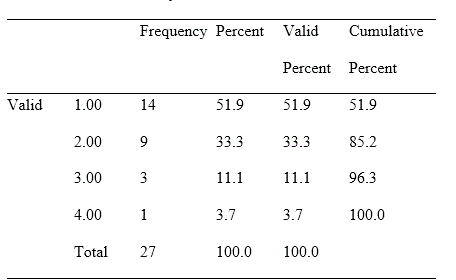
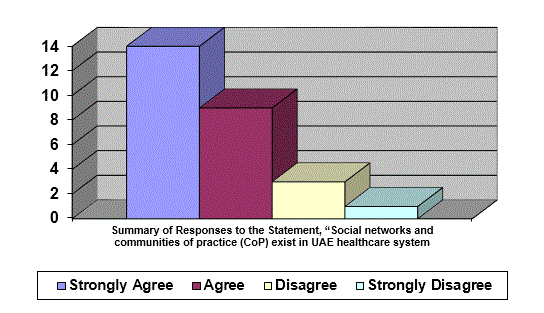
Statement No. 2. Leaders among social networks and communities of practice in the UAE healthcare system can be identified.
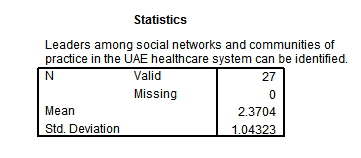
Table __
Summary of Responses to the Statement, “Leaders among social networks and communities of practice in the UAE healthcare system can be identified.”
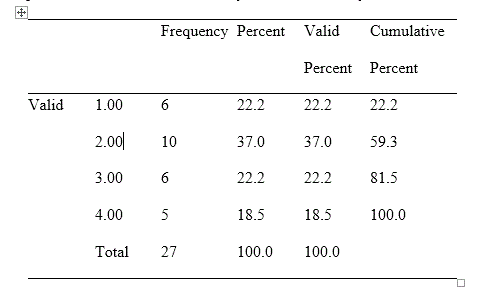
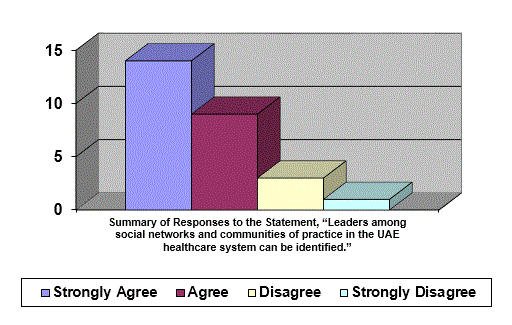
Statement No. 3. Communities of practice networks can be used to improve the diffusion of new innovation between healthcare professionals.
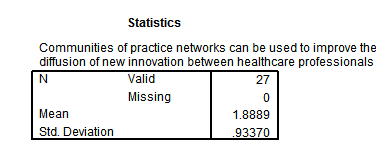
Table __
Summary of Responses to the Statement, “Communities of practice networks can be used to improve the diffusion of new innovation between healthcare professionals.”
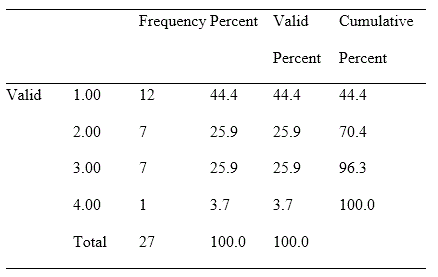
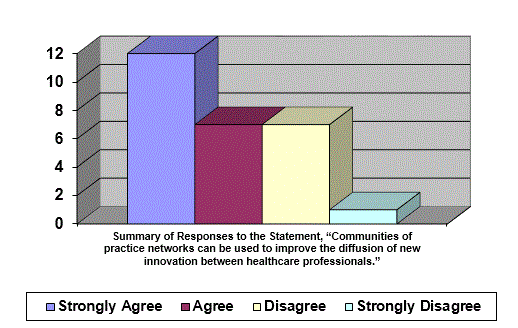
Statement No. 4. Pharmaceutical companies can activate communities of practice networks to improve their resource allocation.
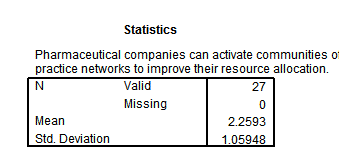
Table __
Summary of Responses to the Statement, “Pharmaceutical companies can activate communities of practice networks to improve their resource allocation.”
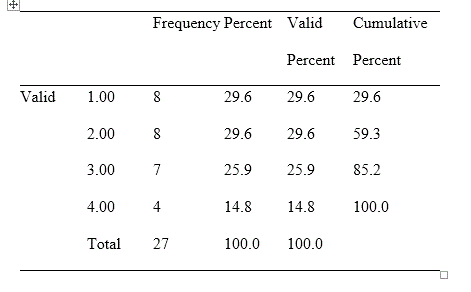
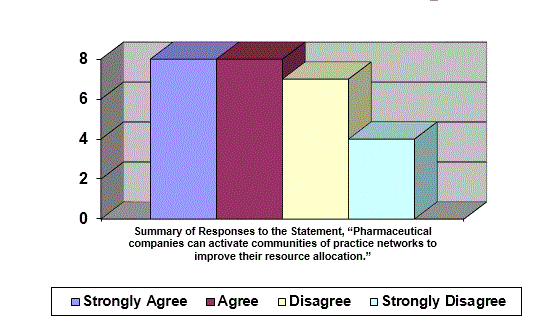
Statement No. 5. Pharmaceutical companies can harness the benefits of communities of practice within their ethical framework.
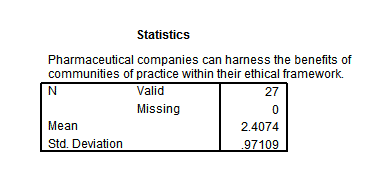
Table __
Summary of Responses to the Statement, “Pharmaceutical companies can harness the benefits of communities of practice within their ethical framework.”
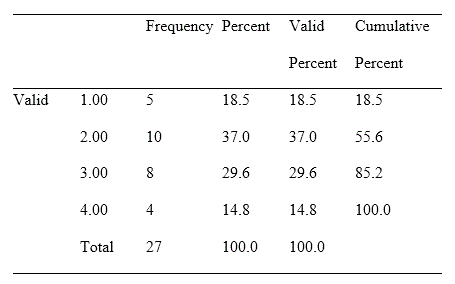
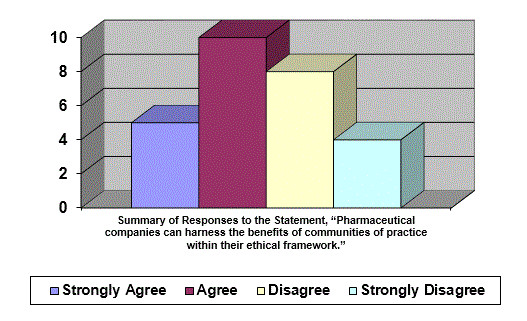
Conclusion
The research showed that to the extent that efficient networks exist among healthcare practitioners is the extent to which data-sharing practices required for effective communication exist. Similarly, to the extent that these networks achieve maturity is the extent to which the diffusion of information and innovations is facilitated on a widespread basis. Diffusion is the process by which innovations are communicated to members of a social system, with communities of practice representing a primary example of such social systems; however, in order for the diffusion of innovation to be effective throughout a community of practice network, there must be a synchronization of communication channels as well as the respective rates of adoption of the network. Consequently, to the degree that these factors are aligned with the others factors involved is the degree to which there will be effective diffusion of innovation; just as importantly, the alignment of these factors will help focus resource allocation where it will do the most good as well as providing a stable framework in which ethical considerations can be taken into account. The community of practice that exists among healthcare professionals in the UAE therefore represents an important component in the diffusion of innovations and new product acceptance.
As noted in the introductory chapter, this study was guided by certain research questions, which are reiterated and answered in sum below based on a synthesis of the review of the relevant literature and the results of the face-to-face interviews with members of the scientific community and the computer-aided telephonic interviews conducted with 27 healthcare practitioners in the UAE.
RQ: Do social networks and communities of practice (CoP) exist in UAE healthcare system and can leaders be identified?
The results of the face-to-face interviews were largely consistent in noting that social networks and communities of practice do in fact exist in UAE healthcare systems, but there was some indication that these networks remain in their nascent stages and will require some time to mature to their full potential. Likewise, there was overall agreement that leaders can be identified, but there was also some mixed views concerning whether recognized experts and authorities in a specialty field could also be viewed as leaders in terms of their role in a social network or community of practice.
Nevertheless, the results of the Internet-based data collection survey overwhelming showed that not only could leaders of social networks and communities of practice be identified, there was widespread agreement among the respondents concerning who these leaders were. The findings are congruent with the results of the computer-aided telephonic interviews as well. For instance, in response to the statement, “Social networks and communities of practice (CoP) exist in UAE healthcare system,” just over half (14 or 51.9%) of the respondents strongly agreed and another nine of the respondents (or 33.3%) agreed; however, three respondents (or 11.1%) disagreed with this statement and one respondent (or 3.7%) strongly disagreed. The mean response was 1.67 with a standard deviation of .83. In response to the statement, “Leaders among social networks and communities of practice in the UAE healthcare system can be identified,” six respondents (or 22.2%) strongly agreed and 10 respondents (or 37%) agreed. Six other respondents (or 22.2%), though, disagreed and five respondents (or 18.5%) strongly disagreed. The mean response to this statement was 2.37 and the standard deviation was 1.04.
Sub-question 1: How can the CoP data be used to improve the diffusion of new innovation between healthcare professionals?
The results of the face-to-face interviews concerning this issue showed that the interviewees believed that communities of practice were much like other types of networks and the mechanics involved in aggregating membership data and determining individual contacts were important elements from the outset. There was some indication from the interviewees as well as many healthcare professionals are inundated with information, and there was a risk of adding further fuel to this information overload unless there was some type of gatekeeping function used to ensure that only the most relevant and important information was diffused throughout the community of practice.
Most of the respondents to the computer-aided telephonic interviews were also of a like mind with regards to this issue. For instance, in response to the statement, “Communities of practice networks can be used to improve the diffusion of new innovation between healthcare professionals,” almost three-quarters (19 or 70.1%) either strongly agreed (12 or 44.4%) or agreed (7 or 25.9%), while seven respondents (or 25.9%) disagreed and one respondent (or 3.7%) strongly disagreed. The mean response to this statement was 1.88 and the standard deviation was .93.
Sub-question 2: How can pharmaceutical companies activate CoP networks to improve their resource allocation?
One interviewee indicated that many drug companies were already taking advantage of existing social networks and that over time, as the community of practice among healthcare practitioners in the UAE matured, lessons would be learned and a set of best practices developed that could help guide similarly situated enterprises. There was also widespread agreement among the computer-aided telephonic interview respondents concerning this issue, with 16 (or 59.2%) either strongly agreeing or agreeing (8 or 29.6% each) with the statement, “Pharmaceutical companies can activate communities of practice networks to improve their resource allocation”; just over a quarter of the respondents (7 or 25.9%), though, disagreed and four respondents (or 14.8%) strongly disagreed with this statement.
Sub-question 3: How can pharmaceutical companies harness the benefits of CoP within their ethical framework?
This was a particularly troublesome issue for both the face-to-face interviewees as well as the computer-aided telephonic interviewees. The former indicated that pharmaceutical companies were faced with a daunting task in balancing their marketing efforts to ensure that they were providing healthcare practitioners with the timely and accurate information they need to make an informed assessment of new products, but there was a fine line involved that one interviewee described as “a slippery slope.” All of the face-to-face interviewees, though, were aware that there were ethical guidelines in place to help pharmaceutical company marketing representatives recognize the difference between aggressive marketing methods and unethical practices. Likewise, the responses to the statement by the respondents in the computer-aided telephonic interviews, “Pharmaceutical companies can harness the benefits of communities of practice within their ethical framework” were somewhat mixed concerning the ability of pharmaceutical companies to take advantage of these networks without comprising the ethical framework, with five respondents (or 18.5%) strongly agreeing and 10 respondents (or 37%) agreeing; however, eight respondents (or 29.6%) disagreed and four respondents (or 14.8%) strongly disagreeing. The mean response to this statement was 2.4 and the standard deviation was .97.
Based on the review of the relevant literature and the results of the series of interviews conducted for this study, the following recommendations are provided:
Since this project relied heavily on feedback from healthcare professionals in UAE, I initially assumed that the biggest obstacle might be getting the access to scientific leaders and acceptance from healthcare professionals to complete the surveys. As an employee with a multinational pharmaceutical company, I attempted to use my contacts and local knowledge to overcome these obstacles.
Time and cost were other obstacles that were anticipated and ultimately encountered, as there was much time and resources spent in the collection, analysis and plotting phases; therefore it was important that these resources, which are scarce by definition, were managed properly. In addition, the methodology used in the study relied heavily on the availability of participating doctors who might have other priorities at hand. In this regard, this researcher attempted to overcome the time hurdle by conducting this research over phases. Fortunately, I was also able to convince my company to endorse the data collection and data analyzing costs on my behalf since this project results can be utilized by the marketing team to improve their resource allocation. No incentive was paid for participating physicians.
From an ethical point of view, most of the doctors who participated in the survey were already a part of a CoP network but they were not necessarily aware of it in these terms; using the elected CoP leaders as a mean to diffuse a new idea or product might have a constructive or destructive consequence on the patients who are being treated by this network. One shouldn’t assume that innovations are always beneficial or free of bias. Moreover, confidentiality was a main concern, and this is why I will declared to all participating doctors that their names would not be mentioned in this dissertation or used for any other reason without their written or oral consent.
The final issue that I became aware during the course of the research was the need to keep in mind my role as an objective researcher and the potential for bias during the research project; especially since I am now employed by a multinational pharmaceutical company in UAE; despite this constraint, it must be acknowledged this was the driving force behind my interest in the topic. Therefore, I needed to ensure that I approached this project from an academic point of view not solely commercial. Because of my current job, I clearly have previous knowledge of who are the key scientific leaders for some inactive healthcare networks in UAE, but I was as careful and judicious as possible in not allowing this knowledge to shade the results that were obtained from the participants.
About us. 2010. International Business Women’s Group. Retrieved from http://www.ibwgdubai.com/.
Bender, D. R. 2000. “No One Is an Island.” Information Outlook 4, no. 4, (April): 5.
Bernstein, M. L., T. McCreless and M. J Côté. 2007. “Five Constants of Information Technology Adoption in Healthcare.” Hospital Topics 85, no. 1, (January 1): 17-25
Bogenrieder, I. and B. Nooteboom. 2004. “Learning Groups: What Types are there?” Organization Studies 25, no. 2: 287-313.
Bonfour, A. 2003. Management of Intangibles: The Organisation’s Most Valuable Assets. London: Routledge.
Buysse, V., K. L. Sparkman and P. W. Wesley. 2003. “Communities of Practice: Connecting What We Know with What We Do.” Exceptional Children 69, no. 3: 263-264.
Cottrell, G. W. 1996. Proceedings of the Eighteenth Annual Conference of the Cognitive Science Society: July 12-15, 1996, University of California, San Diego. Mahwah, NJ: Lawrence Erlbaum Associates.
Carter, E. 2008. “Marketing ‘smart’ medical innovation: physicians’ attitudes and intentions.” International Journal of Pharmaceutical and Healthcare Marketing 2, no. 4, (October 1): 307-320.
Chang, M-H and J. E. Harrington Jr. 2005. “Discovery and Diffusion of Knowledge in an Endogenous Social Network.” The American Journal of Sociology 110, no. 4, (January 1): 937.
Cross, R., T. Laseter, A. Parker, and G. Velasquez. 2005. Assessing and Improving Communities of Practice with Organizational Network Analysis. The Network Roundtable at the University of Virgina.
Day, D. V., Zaccaro, S. J. & Halpin, S. M. (2004). Leader development for transforming organizations: Growing leaders for tomorrow. Mahwah, NJ: Lawrence Erlbaum Associates.
de Cagna, J. (2001, July). Tending the garden of knowledge: a look at communities of practice. Information Outlook, 5(7), 6-7.
Dennis, C., & Harris, L. 2002. Marketing the e-Business. London: Routledge.
Desouza, K., C. Dombrowski, Y. Awazu, P. Baloh, S. Papagari, S. Jha, and J. Kim. 2009. “Crafting organizational innovation processes.” Innovation: Management, Policy & Practice 11, no. 1, (April 1): 6-33.
Droege, S. B. and J. M. Hoobler. 2003. “Employee Turnover and Tacit Knowledge Diffusion: A Network Perspective.” Journal of Managerial Issues 15, no. 1: 50-64.
Dube, L., A. Bourhis, and J. Real. 2005. “The Impact of Structuring Characteristics on the Launching of Virtual Communities of Practice.” Journal of Organizational Change Management 18, no. 2: 145-168 in Hemmasi & Csanda, 2009 at 263.
Erwin, D. 2009. Changing Organizational Performance: Examining the Change Process. Hospital Topics 87, no. 3, (July 1): 28-40.
Fincher, S. & Tenenberg, J. (2006). Using theory to inform capacity-building: Bootstrapping communities of practice in computer science education research. Journal of Engineering Education, 95(4), 265-266.
Fraenkel, J. R. & Wallen, N. E. 2001. Educational Research: A Guide to the Process. Mahwah, NJ: Lawrence Erlbaum Associates.
Fuentelsaz, L., J. Gómez, and S. Palomas. 2009. “The effects of new technologies on productivity: An intrafirm diffusion-based assessment.” Research Policy 38, no. 7, (September 1): 1172.
Gongla, P. and C. R. Rizzato. 2001. “Evolving Communities of Practice: IBM Global Services Experience.” IBM Systems Journal 40, no. 4: 842-862.
Grossmeier, J. C. 2007. “Adopting and Implementing a Policy Governance Model.” Journal of Healthcare Management 52, no. 5, (September 1): 343-50. Pg. 346 approaches to management.
Hemmasi, M. and C. M. Csanda. 2009. “The Effectiveness of Communities of Practice: An Empirical Study.” Journal of Managerial Issues 21, no. 2: 262-264.
Holly, J., M. Wong, W. Legnini, H. H. Whitmore and R. S. Taylor. 2000. “The diffusion of decision support systems in healthcare: Are we there yet? Practitioner application.” Journal of Healthcare Management 45, no. 4, (July 1): 240-9; discussion 249-53.
Huesch, M. 2009. “Comment on ‘The Diffusion of a Medical Innovation: Is Success in the Stars?’” Southern Economic Journal 75, no. 4, (April 1): 1270-1273
Inamdar, N., R. S. Kaplan, and K. Reynolds. 2002. “Applying the balanced scorecard in healthcare provider organizations / Practitioner’s Response.” Journal of Healthcare Management 47, no. 3, (May 1): 179-95; discussion 195-6.
James, C. R. 2002. “Designing Learning Organizations.” Organizational Dynamics 32 (1): 46- 61.
Jonassen, D. H. and S. M. Land. 2000. Theoretical Foundations of Learning Environments. Mahwah, NJ: Lawrence Erlbaum Associates.
Lave, J. 1993. “Situating learning in communities of practice”. In L. B. Resnick, J. M. Levine,& S. D. Teasley (Eds.), Perspectives on socially shared cognition (pp. 17-36). Washington, DC: American Psychological Association.
Lave J. and E. Wenger E. 1991. Situated Learning: Legitimate Peripheral Participation. New York: Cambridge University Press.
Lee, J. L. & Valderrama, K. (2003, May). Building successful communities of practice. Information Outlook, 7(5), 28-29.
Mission & Objective. 2010. Dubai Chamber of Commerce. Retrieved from http://www.dubaichamber.ae/.
Rogers, E. M. 2003. Diffusion of Innovations, Fifth Edition, Free Press
UAE business associations. 2010. UAE Links.com. Retrieved from http://www.uaelinks.com/dir/uae-business-associations.
UAE country profile. 2007. U.S. Library of Congress. Retrieved from http://lcweb2.loc.gov/frd/cs/profiles/UAE.pdf.
Vázquez-Barquero, A. 2002. Endogenous Development: Networking, Innovation, Institutions, and Cities. London: Routledge.
Wallace, J. and J. Loughran. 2003. Leadership and Professional Development in Science Education: New Possibilities for Enhancing Teacher Learning. London: RoutledgeFalmer.
Wenger, E. 1991. “Communities of Practice: Where Learning Happens.” Benchmark Magazine Fall: 6-8.
Wesley, P. W. and V. Buysse. 2001. “Communities of Practice: Expanding Professional Roles to Promote Reflection and Shared Inquiry.” Topics in Early Childhood Special Education 21, no. 2: 114-115.
Wood, G. D. & Ellis, R. C. 2003. “Risk management practices of leading UK cost consultants.” Engineering, Construction and Architectural Management, 10(4), 254-62.

Comments